Alain Passard - Accelerate The Pig!
January 2009 - Centurion Magazine
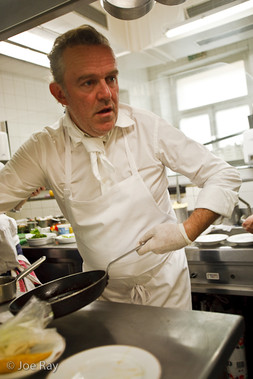
The Changing Man
Maverick French chef Alain Passard reveals his ever-evolving culinary style, ‘grand cru’ vegetables and continuing his mother’s legacy
PARIS - Very little talking happens in Alain Passard’s kitchen. Crammed into a tight space, everyone has a job, knows it and doesn’t say much. The man himself refers to everyone working for him as ‘monsieur’ or ‘madame’. They, in turn, call Passard ‘Chef’, with a capital ‘C’.
Outside of the kitchen, however, Chef has evolved and changed so much since opening his Michelin three-star restaurant, L’Arpège, nobody, from his critics to his legions of admirers, is sure what to call him.
Passard, however, appears comfortable enough, arriving to work dressed in trendy jeans, boots, a starched white shirt with French cuffs, a Polo hoodie and – for a bit of Gallic flair – a green silk scarf. His full head of salt and pepper hair is long enough in the back that he could be on his way to a gig with the Stray Cats.
“I’m a roaster,†he says, referring to the skill that made him famous – a trade he learned from his Breton grandmother, Louise, who has the honour of being the only photo in Passard’s modest-sized dining room.
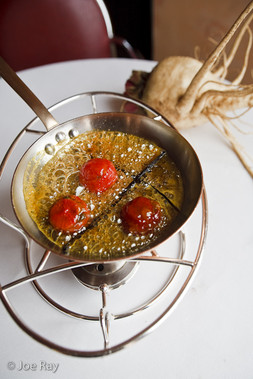 After making his name as a roaster, Passard has now expanded his repertoireto include the vegetables from his own gardens. Above, his famous tomate confite farcie aux douze saveurs. Photos by Joe Ray
After making his name as a roaster, Passard has now expanded his repertoireto include the vegetables from his own gardens. Above, his famous tomate confite farcie aux douze saveurs. Photos by Joe RayAt least he was a roaster until a mad cow disease scare ripped through France in 2000.
“Rungis told me they had done everything they could,†he says, referring to the mammoth wholesale food market that supplies products to Parisian restaurants, “but they couldn’t be sure everything they sold was untainted.”
There must have been a moment in this roaster’s mind when he thought, ‘My goose is cooked,’ and while some might say he shifted gears to adapt, others think he got out of the car, jumped on a tractor and drove into the countryside looking for solutions.
Not only did Passard give up on meat in early 2001, a move which made big waves in the three-star world, he rejected the entire food production chain – all the way down to the farmer – and started growing his own vegetables.
“Now, I want a passport,†he declares, describing the guarantee of provenance and quality he seeks, “…for everything.â€
In 2002, he began growing his own vegetables on a two hectare farm in the French countryside, an idea that flourished to the point that there are now three farms spread across a total of six hectares in north-west France: one in the Sarthe, one in Normandy and another near Mont-Saint-Michel. Passard’s team of twelve farmers not only furnishes L’Arpège with produce, they also sell their goods to other restaurants and at a countryside market stand.
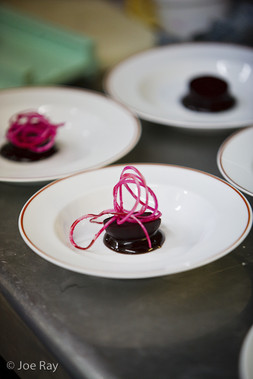 In the kitchen at restaurant L’Arpège in Paris, tiny beets (above) sit on a pudding-like mixture of Banyuls wine and cacao.Photos by Joe Ray
In the kitchen at restaurant L’Arpège in Paris, tiny beets (above) sit on a pudding-like mixture of Banyuls wine and cacao.Photos by Joe Ray“I want ‘grand cru’ vegetables. I want to talk about the carrot the way a sommelier talks about Chardonnay,†he explains.
“We have a winemaker dynamic where I tell my gardeners the same thing I tell my cooks; you’ve got to taste, otherwise, it’s useless. We’ll taste onions, shallots or garlic from each farm and say ‘There! That’s where it’s best!’â€
After his long stint cooking vegetables to the exclusion of more traditional proteins (large squash and pumpkins still serve as voluptuous table and window decorations), Passard has now worked his way back into meats, fish and poultry, but he keeps strict tabs on his products’ passports.
On cue, passport holder Bernard Antony, one of the premier fromagers and affineurs (cheese agers) in France and the provider of the ultra-rare three- and four-year old Comté served at L’Arpège, walks through the front door and gives Passard a kiss on each cheek.
I ask Chef if his “antique volaille du Haut-Maine au foin et vin de paille†is made with the famous French chicken known as poulet de Bresse, and Passard scoffs like I’ve insulted a friend. “Non! It’s Pascal Cosnet!†(I’ll later learn Cosnet runs the Ferme du Patis near Le Mans.) [The volaille, incidentally, is one of Passard’s signature dishes with chicken cooked on a bed of hay in a large Le Creuset pot.]
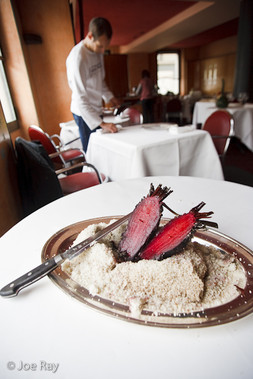 Slow-roasted beet cooked in a croute de sel de Guérande at Alain Passard’s Michelin three-star restaurant, L’Arpège in Paris. Photos by Joe Ray
Slow-roasted beet cooked in a croute de sel de Guérande at Alain Passard’s Michelin three-star restaurant, L’Arpège in Paris. Photos by Joe RayTo continue digging my grave, I ask how much of the produce in the restaurant is grown on his farm and how much he buys. Chef shudders at my ignorance. “There’s not a single carrot that doesn’t come from my farms!†he exclaims. Later, I wonder which of his three farms has the right growing conditions for the limes he uses in his kitchen and I pretend not to be listening when Chef and his assistant talk about the variety of organic apples they bought, but I get Passard’s point; it’s easy to understand that, animal or vegetable, they’re all his babies, prepared his way.
This can mean slow-roasted beets in a Guérande salt crust – deep coloured rubies that emerge from a salty shell or other, smaller beets that leave the kitchen as an amuse bouche on top of what looks like a dark pudding. Sous chef Anthony Beldroega catches me staring, smiles and simply says, “Banyuls. Cacao,†while handing me a plastic spoonful of the creation.
The thick, earthy combination of the port-like wine and chocolate simultaneously pulls my taste buds in two different directions and without realising it, I grin.
On the other side of the kitchen, past a stove covered with pots and pots of slowly braising vegetables and some of Passard’s famous tomate confite farcie aux douze saveurs, is a small grill with a whole chicken and some pork cooking over chunks of hickory.
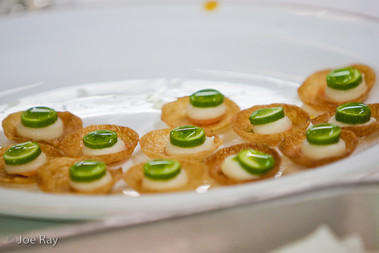 Amuse bouches await to go out to the dining room. Photos by Joe Ray
Amuse bouches await to go out to the dining room. Photos by Joe RayAt one point just before lunch service begins, Chef looks up at the clock, down at the pork, and commands: “Accelerate the pig!†Next to it, there’s the chicken I’ve insulted, removed from the nest of hay it was partially cooked in while sealed inside a Dutch oven. Now, it’s held in the perfect grilling position with spoons cleverly wedged between grill grates.
Later, with the pig still insufficiently accelerated, Passard improvises a little and flattens the pork against the heat using the heavy Dutch oven formerly used to cook the chicken.
Problem solved.
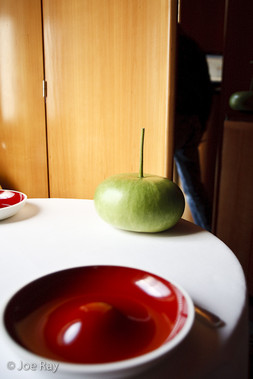 Stil life with gourds in the dining room.Photos by Joe Ray
Stil life with gourds in the dining room.Photos by Joe RayAs Chef tells it, his cooking method is merely the result of paying attention to the grande dame whose photo hangs on his wall.
“They’re all her recipes,†he says simply, pointing to Louise Passard’s picture. “She gave me everything, taught me what to look for when I made my first purchases, taught me the right cooking times and temperatures.â€
She also taught him how to mix the arts of creating and hosting, something he’s worked to blend since opening L’Arpège. On the floor, an oasis of tranquility where he often spends generous amounts of time speaking to clients, he knows who came for lunch yesterday and how al dente someone else likes their risotto.
During lunch, he floats in and out of the kitchen – a beehive of activity, packed with almost as many cooks as there are diners in the restaurant – yet he can walk in and immediately know exactly what’s going on at any station at any given moment. He conducts the orchestra, but also loves to put his head down and jump into the fray.
“My grandmother had a sense of fire and the strength of fire, but she always liked pleasing people,†he explains. “The common thread that’s run through the restaurant’s history is her combination of passion and pleasure.”
-fin-
See the .pdf version of this story as it ran in American Express Centurion Magazine here